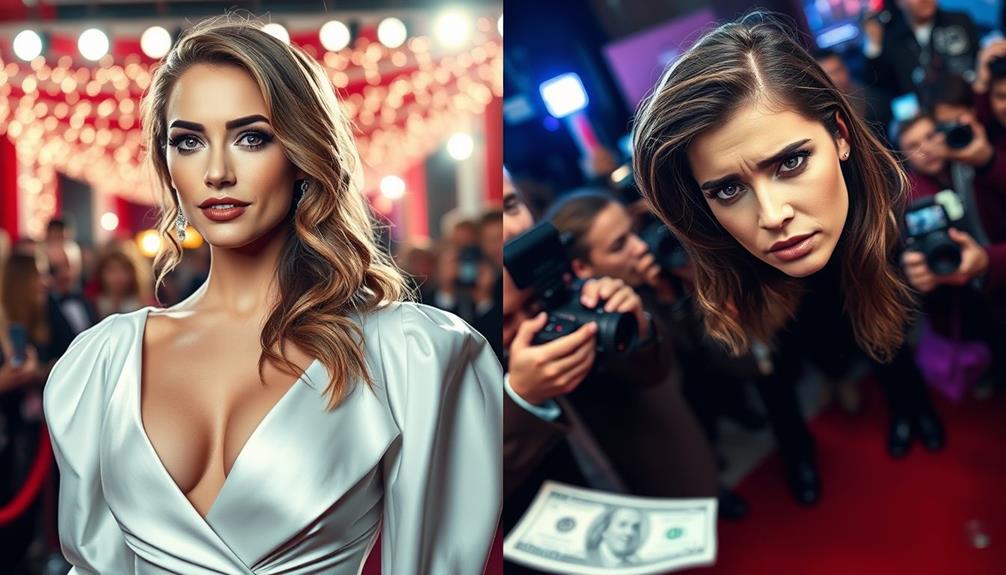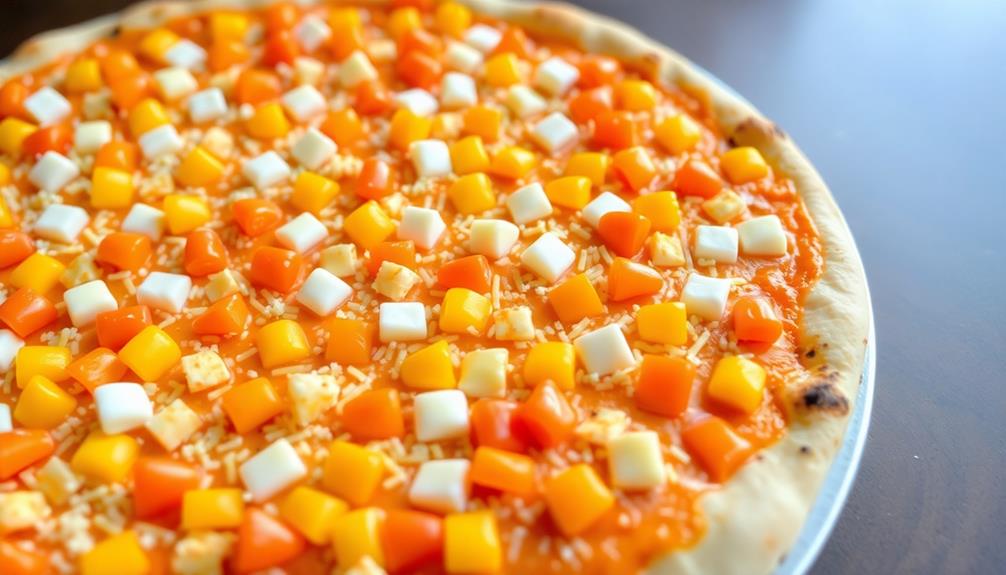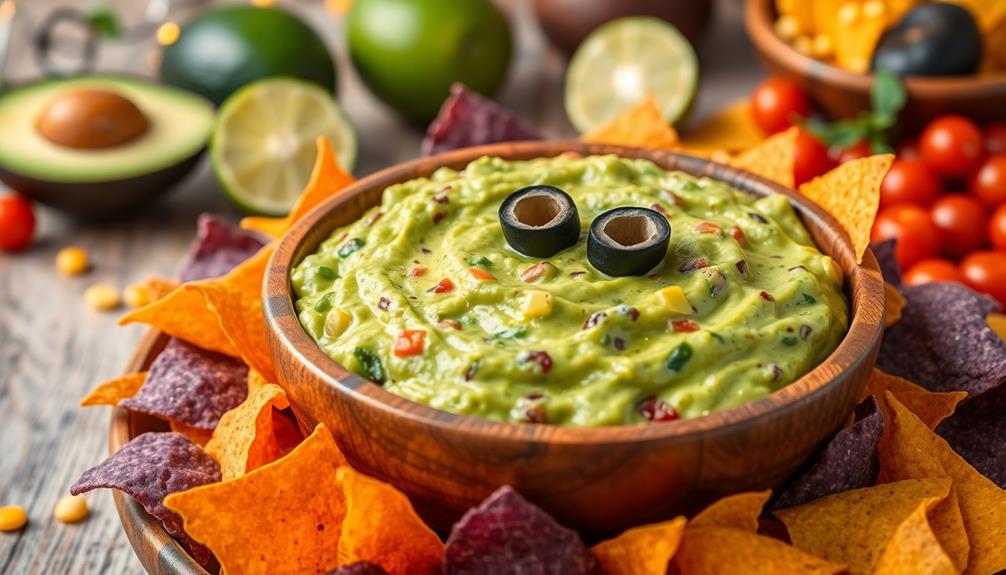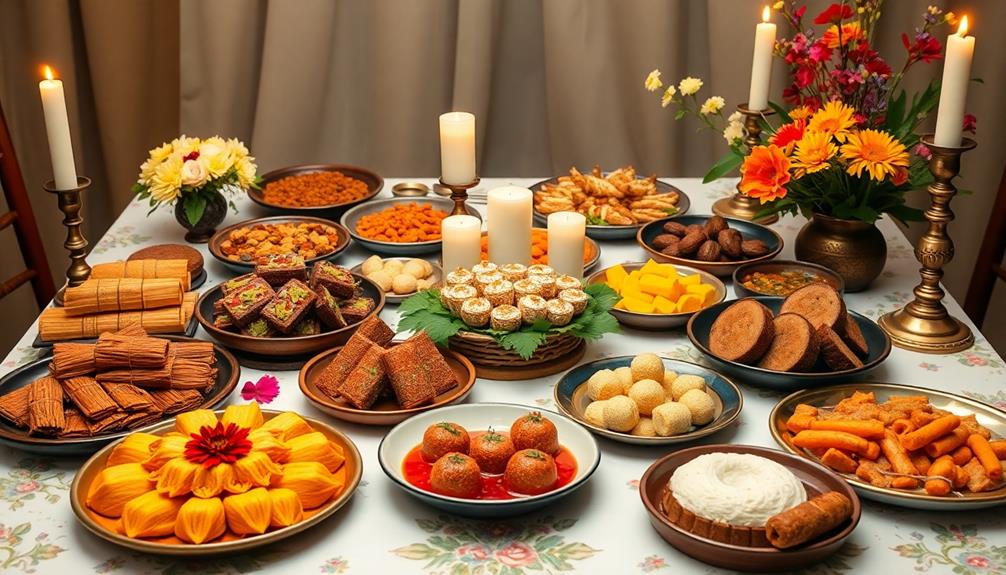The material of your cooking vessel markedly influences flavor development in your dishes. For instance, cast iron retains heat well, enriching flavors in slow-cooked meals, while stainless steel promotes browning through the Maillard reaction, adding depth to your creations. Non-stick surfaces help preserve delicate ingredients' natural flavors by reducing oil usage. Each material also affects aroma retention, impacting overall dish quality. By selecting the right cookware based on these properties, you can enhance the complexity of your meals. Stick around to uncover even more tips on optimizing your cooking experience and maximizing flavor.
Key Takeaways
- The material of cooking vessels affects heat retention and transfer, influencing flavor development in dishes significantly.
- Cast iron enhances deep flavors through excellent heat retention, while stainless steel promotes browning via the Maillard reaction.
- Non-stick cookware preserves delicate flavors by minimizing fat usage, making it ideal for sensitive ingredients.
- Aroma retention varies by material, with ceramic preserving moisture and enhancing flavors in soups and stews.
- Proper maintenance of cookware, like seasoning cast iron, contributes to long-term flavor enhancement and consistency in dishes.
Importance of Cooking Vessel Material
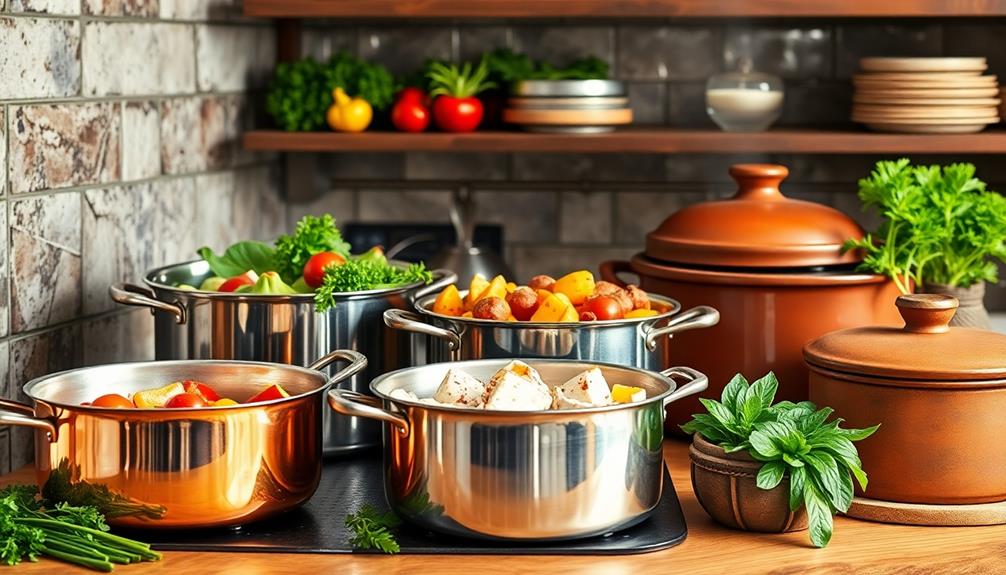
When it comes to cooking, the material of your vessel matters more than you might think. The choice of cookware material can greatly influence flavor development, impacting your dishes' sensory characteristics.
For instance, cast iron enhances flavors through its ability to retain high heat and develop a natural seasoning over time. This makes it perfect for searing meats and slow cooking, allowing complex flavor profiles to emerge. Similarly, when preparing dishes like Red-Braised Pork Belly, the right vessel can help achieve that tender, caramelized texture that's so revered.
On the other hand, stainless steel is celebrated for its durability and non-reactive nature. It excels at promoting the Maillard reaction, which leads to browning and caramelization, enriching your sauces and enhancing overall taste.
If you're preparing delicate ingredients, non-stick cookware offers a lighter cooking option, reducing the need for oil while maintaining the integrity of your seafood or eggs.
Ultimately, understanding the importance of cooking vessel material can elevate your culinary creations. By selecting the right cookware, you can reveal deeper flavors and textures, making every meal a delightful experience.
Heat Transfer Properties

The heat transfer properties of different cookware materials can greatly affect how your food cooks, ultimately influencing flavor development. Each material has unique heat transfer rates that determine how evenly and quickly your food cooks.
For instance, cast iron excels at retaining heat, ensuring consistent temperatures that enhance the Maillard reaction. This leads to richer flavors in your seared meats and vegetables, much like the robust flavors found in traditional Brazilian dishes such as Caruru, which combines indigenous, African, and Portuguese influences.
Stainless steel, on the other hand, heats up quickly and evenly, promoting good browning and allowing for effective deglazing. This is essential for creating flavor-packed sauces and gravies.
If you're using non-stick cookware, you'll find it reduces the need for additional fats, preserving the natural flavors of delicate foods like fish and eggs.
Additionally, materials like aluminum boast high thermal conductivity, which means they transfer heat rapidly. This is particularly beneficial for techniques that require precise temperature control, such as sautéing.
Impact on Flavor Development
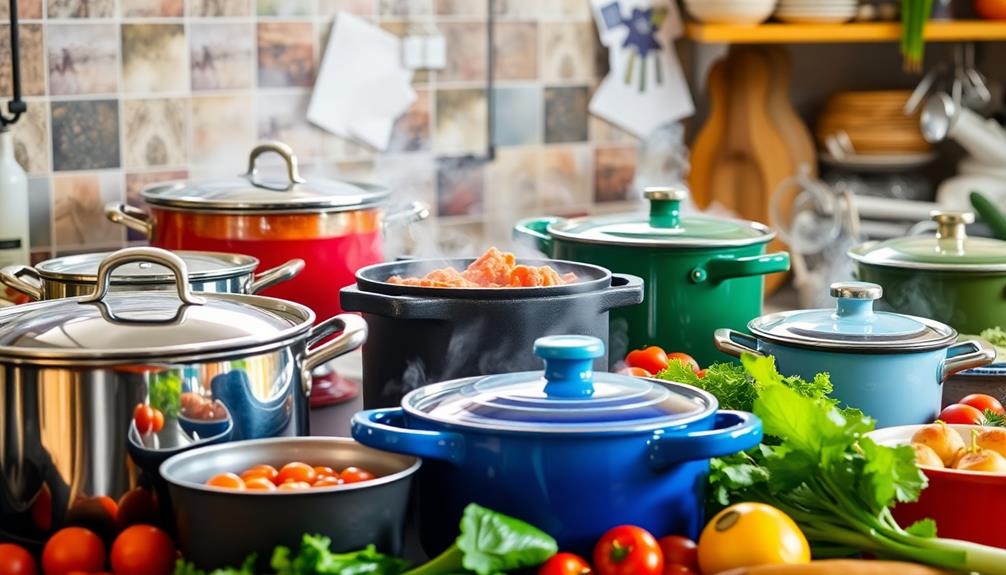
The material of your cooking vessel plays a vital role in flavor development, influencing how heat affects flavor compounds.
For instance, using copper can enhance precision cooking, while cast iron's heat retention builds deeper flavors over time.
In dishes like Nettle and Potato Soup, the choice of vessel can affect the creamy texture and how the fresh ingredients meld together.
Additionally, the choice of material can impact aroma retention, ensuring your dishes taste as vibrant as they should. Aroma retention is particularly important when it comes to dishes with delicate or complex flavors, as the right material can help prevent the aroma from escaping and dissipating. In fact, there is a science behind palate cleansers in dining, as certain materials can help to reset the palate and enhance the appreciation of each subsequent flavor. By understanding and utilizing the science behind palate cleansers in dining, chefs and diners alike can ensure that every bite is as enjoyable and satisfying as it should be. The science of palate cleansers also extends to the choice of cookware and serving dishes, as certain materials can help to enhance the overall dining experience. For example, porous materials like wood and unglazed ceramics can absorb flavors and aromas, making them ideal for serving dishes with strong or lingering aromas. On the other hand, non-porous materials like stainless steel and glass are better for preserving the delicate aromas of more subtle dishes. By understanding the science of palate cleansers and the impact of material choice, chefs can elevate the flavors of their dishes and diners can fully appreciate the complex and nuanced flavors of their meals.
Material Heat Transfer Effects
Different cooking vessel materials can dramatically influence how heat transfers during the cooking process, directly impacting flavor development. The heat transfer rates of your cookware determine how effectively it cooks your food, which in turn affects the flavors that develop.
For instance, using cast iron when preparing traditional Mexican dishes like chilaquiles can enhance the browning of ingredients, enriching the overall taste.
- Copper pans provide rapid and even heating, perfect for precision cooking and enhancing flavor development.
- Cast iron retains heat exceptionally well, promoting browning and intensifying flavor profiles.
- Stainless steel, while durable, can lead to sticking if not heated properly, potentially stifling the Maillard reaction essential for flavor complexity.
Each material's heat retention and distribution properties play a significant role in how your dish turns out.
For example, ceramic cookware helps preserve moisture and nutrients, resulting in a tastier meal, while non-stick surfaces allow for healthier cooking with less fat.
Understanding these heat transfer effects can help you choose the right cooking vessel material, ensuring your meals not only cook evenly but also develop the rich, complex flavors you desire.
Impact on Flavor Compounds
Understanding how cooking vessel materials influence flavor compounds can transform your culinary experience. The choice of cooking vessel materials directly impacts flavor development through their effect on heat distribution and retention.
For instance, stainless steel and cast iron vary in how they engage the Maillard reaction, which is essential for creating complex flavors during browning. Cooking with materials that retain heat well can be particularly beneficial when preparing dishes such as Hiyashi Chuka, where the balance of flavors is vital.
Non-stick cookware can alter flavor profiles since it minimizes the need for added fats, reducing the richness you'd typically expect from oils and butters. Conversely, clay pots provide slow, even heating, helping preserve delicate volatile flavor compounds in your stews and soups.
Using cast iron can enhance your dishes' taste, thanks to its seasoning and the unique interaction between food and the iron surface. This interaction fosters chemical reactions that deepen flavors.
Additionally, materials like copper boast excellent thermal conductivity, allowing for precise temperature control essential for developing flavors in delicate sauces and confections.
Aroma Retention Variations
A variety of cooking vessel materials can greatly impact how well aromas are retained during the cooking process. Different materials interact with volatile organic compounds and flavor components, affecting overall aroma retention.
For instance, stainless steel promotes browning, enhancing the development of Maillard reaction products, while cast iron retains heat, resulting in complex flavors. Traditional dishes like Muamba De Galinha benefit from these interactions, as the choice of vessel can enhance the richness of the dish.
Here are some key aspects to take into account:
- Ceramic cookware preserves moisture, preventing evaporation of aromatic compounds, intensifying flavors in soups and stews.
- Non-stick surfaces minimize the loss of delicate aroma compounds, making them perfect for seafood that relies on its natural flavors.
- High heat conductivity materials, like hard anodized aluminum, enhance the release of aroma compounds, creating more fragrant dishes.
Choosing the right cooking vessel is essential for maximizing aroma retention. Each material contributes uniquely to how flavors develop, ensuring your dishes aren't only tasty but also aromatic.
Material Comparison: Cast Iron vs. Stainless Steel
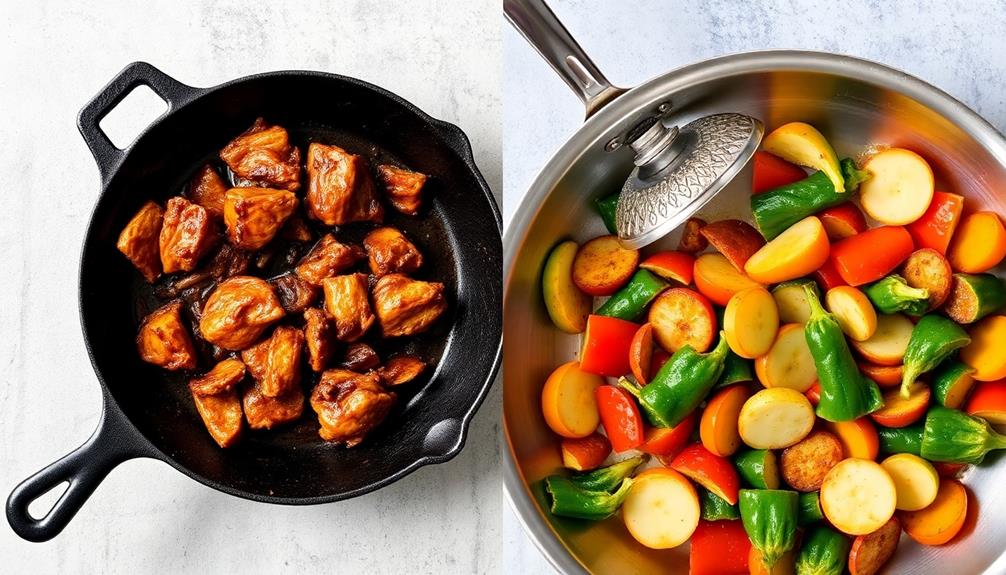
When choosing between cast iron and stainless steel cookware, you'll find that each material offers unique advantages that can greatly impact flavor development in your dishes.
Cast iron excels in heat retention and even heat distribution, making it perfect for slow cooking methods that deepen flavors in braised dishes, such as Braised Beef in Barolo Wine. Its ability to maintain consistent temperatures helps achieve a well-seared crust on meats and vegetables, enhancing their taste.
On the other hand, stainless steel is known for its durability and non-reactive properties. This material allows for precise temperature control, making it ideal for browning and deglazing, which adds complexity to your sauces.
While cast iron develops a natural non-stick surface through seasoning, stainless steel requires fats or oils to prevent sticking, which can influence the cooking methods you choose.
It's also essential to note that cooking acidic foods in cast iron can alter their flavor profile due to reactivity, whereas stainless steel remains neutral and won't impart any metallic taste.
Ultimately, your choice between cast iron and stainless steel will depend on the specific cooking techniques and flavors you want to achieve in your culinary creations.
Non-Stick Surfaces and Flavor
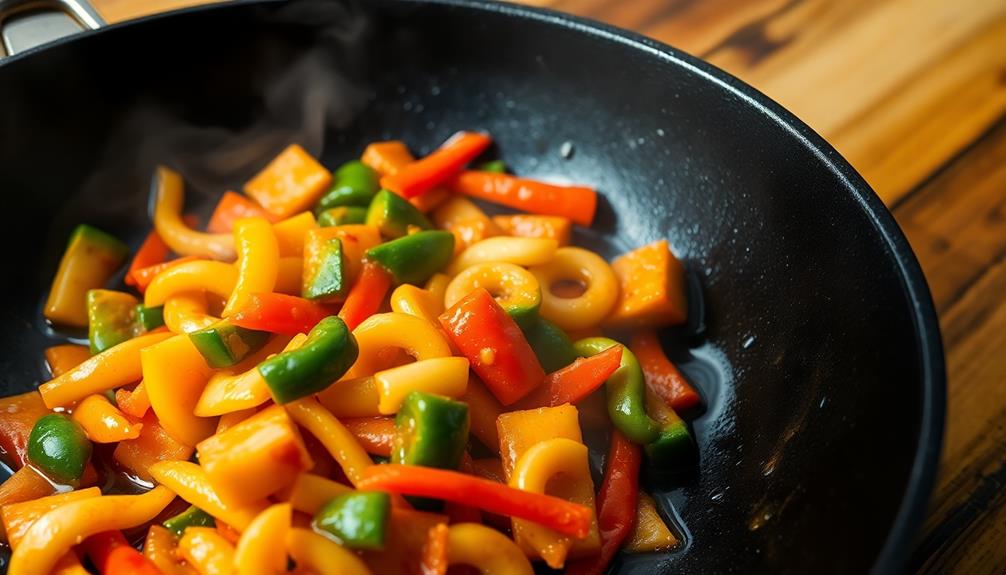
Non-stick surfaces offer a unique approach to cooking that can influence flavor development in different ways than traditional materials like cast iron or stainless steel. Typically coated with PTFE or ceramic, these surfaces prevent food from sticking, allowing you to use less oil and fat while retaining the natural flavors of your ingredients.
For instance, when preparing festive dishes like Graveyard Taco Dip, the use of non-stick cookware can help maintain the freshness of the guacamole and other layers without unwanted sticking.
However, the lower heat retention of non-stick cookware can limit the development of complex flavors, particularly those achieved through browning. This can be a drawback when using high-heat cooking methods like searing, which are essential for creating rich, caramelized flavors.
Here are some benefits of non-stick surfaces:
- Perfect for delicate foods like eggs and fish, preserving their natural flavors.
- Encourages healthier cooking with less oil and fat.
- Easy to clean, promoting a wider variety of dishes without flavor transfer.
While non-stick surfaces enhance convenience, they mightn't deliver the same depth of flavor found in materials like cast iron or stainless steel, which excel at browning and caramelization.
If you prioritize flavor development, consider integrating various cooking vessels into your kitchen repertoire.
Influence of Temperature Control
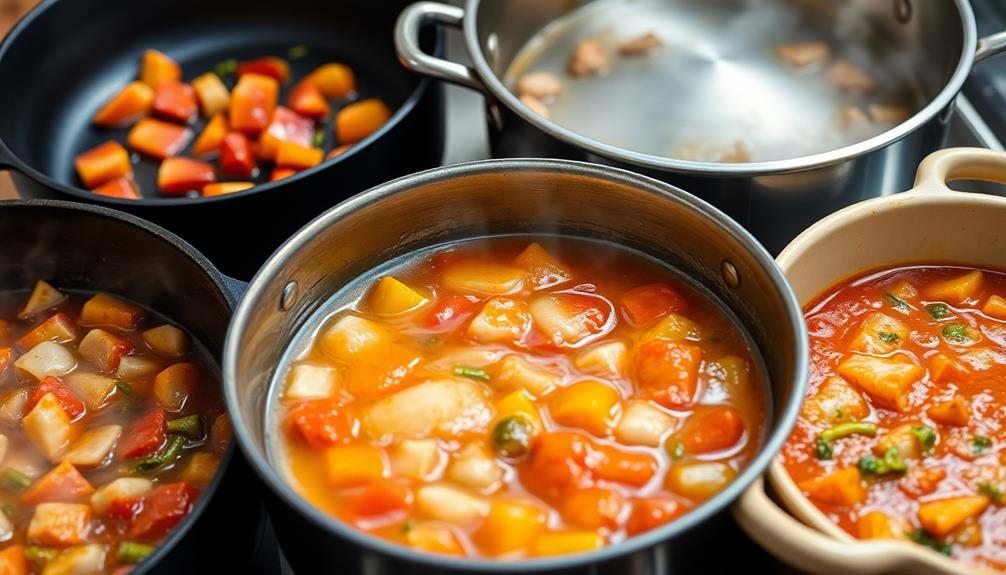
Temperature control plays a pivotal role in flavor development during cooking. The material of your cooking vessel directly impacts heat conduction and retention, essential for maintaining consistent temperatures. For instance, stainless steel cookware offers rapid heat conduction, which enhances the Maillard reaction, resulting in richer flavors in seared foods. Conversely, cast iron excels in heat retention, allowing for even cooking at lower temperatures, perfect for developing deep, complex flavors in slow-cooked dishes.
The temperature control also influences the evaporation rate, which can concentrate flavors. A wide, shallow pan promotes faster evaporation, intensifying the taste of sauces or reductions.
Here's a table to visualize the impact of different materials on temperature control and flavor:
| Cooking Vessel Material | Key Benefit |
|---|---|
| Stainless Steel | Rapid heat conduction |
| Cast Iron | Excellent heat retention |
| Non-Stick | Lower heat settings |
| Copper | Superior heat distribution |
| Aluminum | Lightweight, quick heating |
Understanding these differences helps you choose the right vessel, ensuring your culinary creations shine with exceptional flavor development.
Effects of Shape and Size
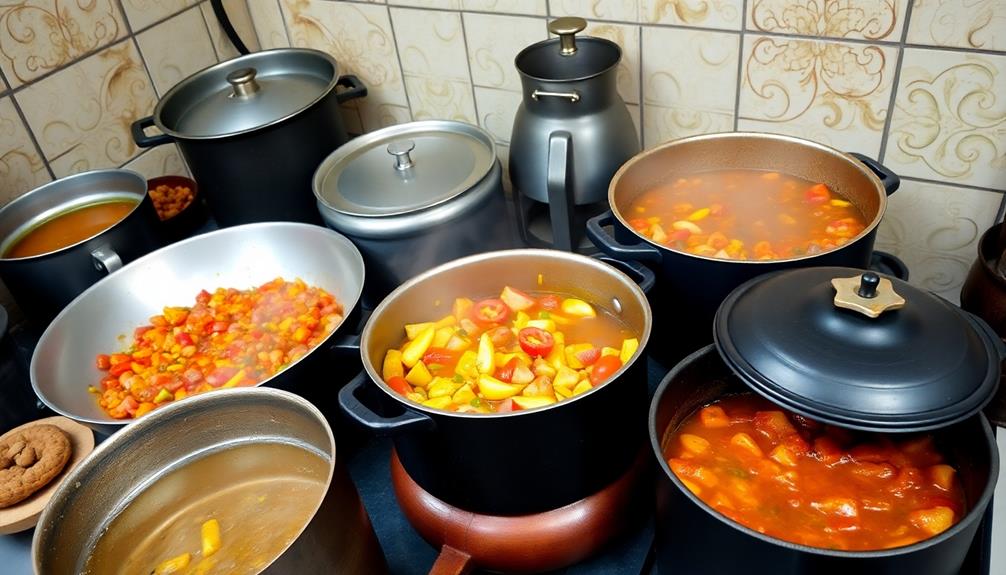
The shape and size of your cooking vessel can markedly influence flavor development in your dishes. Choosing the right vessel isn't just about aesthetics; it's vital for maximizing the flavors in your meals.
For instance, using a wide, shallow pan when preparing dishes like Mushroom Masala promotes evaporation and browning, enhancing flavor concentration. Deep pots are perfect for braising and stewing, as they retain moisture and enrich the flavor profile through slow heat infusion. Properly sized cookware helps maintain ideal cooking temperatures, preventing overcooking or burning.
The design of your cooking vessels plays a significant role in moisture retention. For instance, pots with curved sides facilitate steam condensation, which helps keep volatile flavor compounds in your dish.
Additionally, larger pots allow for even heat distribution, preventing overcrowding and ensuring that every ingredient cooks consistently. This uniform cooking is essential for developing robust flavors.
Long-Term Flavor Enhancement
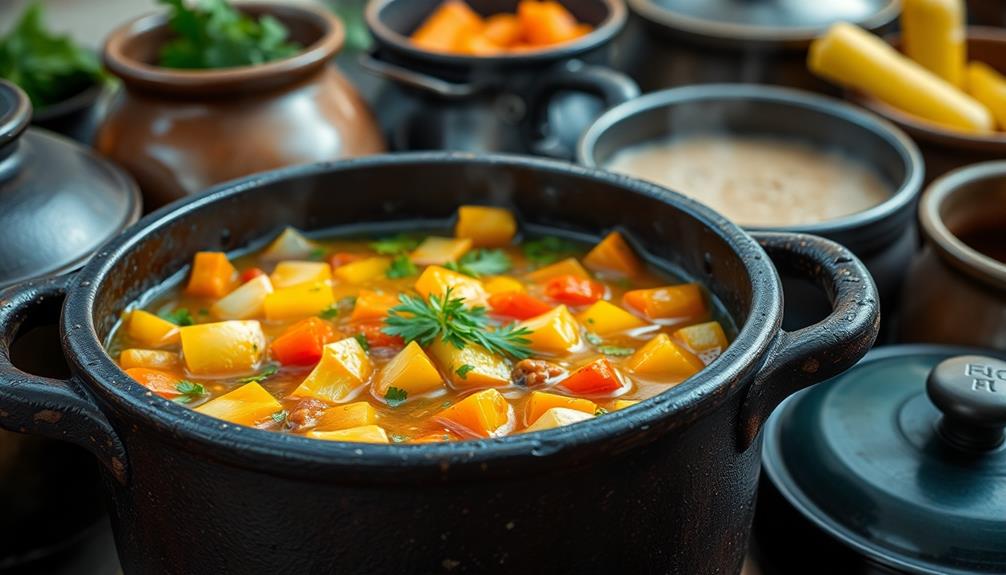
Over time, the material of your cooking vessels can profoundly enhance the flavors in your dishes. For instance, using cast iron not only guarantees excellent heat retention but also allows for the formation of a seasoned surface. This seasoned layer develops over time, imparting subtle flavors from previous meals into each new dish you prepare.
| Cooking Vessel Material | Flavor Enhancement Characteristics |
|---|---|
| Cast Iron | Superior heat retention; seasoned surface adds flavor |
| Stainless Steel | Excellent conductivity; enhances browning for complex flavors |
| Copper | Precise heat control; ideal for delicate sauces |
| Ceramic | Even cooking; moisture retention promotes natural sweetness |
Choosing the right material matters for long-term flavor development. While non-stick cookware is convenient, it can limit flavor depth due to reduced fat usage. Alternatively, ceramic dishes enhance flavors through moisture retention, allowing ingredients to shine without burning. By selecting quality materials, you're investing in a cooking experience that enriches the taste of your food over time, creating dishes that are not only delicious but also uniquely yours.
Maintenance and Care of Vessels
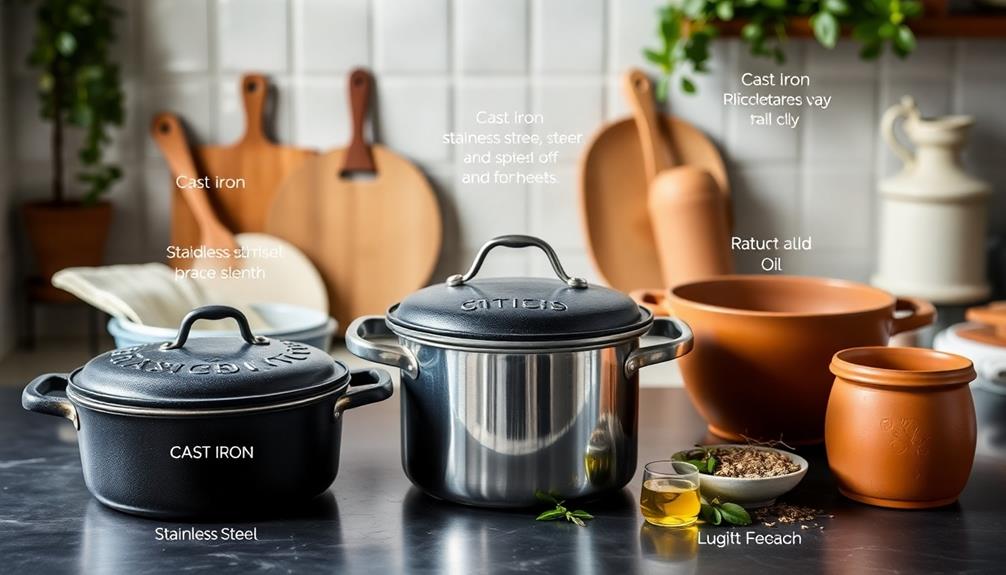
Proper maintenance and care of your cooking vessels can greatly extend their lifespan and enhance the flavors they help create. By taking the time to properly care for non-stick, cast iron, and stainless steel cookware, you'll guarantee peak flavor development in your meals.
For instance, using cast iron cookware can enhance the rich, unique flavors of traditional dishes like Ethiopian salads and roasted barley.
- Use non-abrasive sponges for cleaning non-stick cookware to prevent damage to the coating.
- Season cast iron vessels regularly with oil to maintain their non-stick properties and prevent rust.
- Clean stainless steel cookware with a vinegar and baking soda mixture to remove discoloration.
Additionally, proper storage is essential; using protective liners between stacked pans prevents scratches and damage that could affect cooking efficiency and flavor transfer.
Regularly inspect your cookware for signs of wear, like peeling non-stick surfaces or rust in cast iron, as this is critical for both safety and flavor integrity.
By following these maintenance tips, you'll not only prolong the life of your vessels but also guarantee they perform at their best, allowing the unique flavors of your ingredients to shine through.
Happy cooking!
Practical Cooking Tips
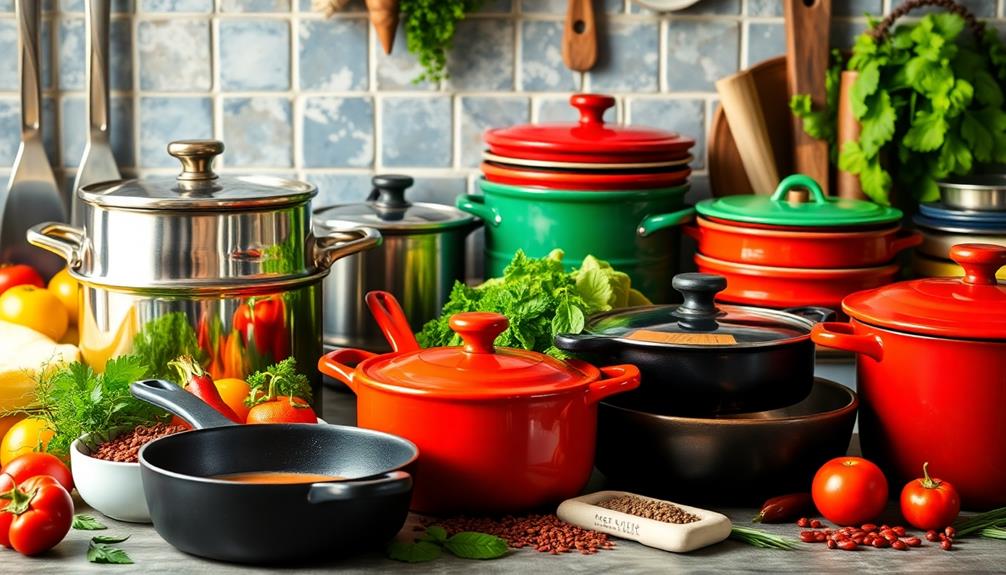
When it comes to enhancing your culinary creations, understanding the strengths of different cooking vessel materials can make a significant difference.
Start by choosing non-stick cookware for delicate dishes, like fish or eggs. This minimizes the need for added fats and prevents your ingredients from breaking apart.
If you're slow cooking or searing meats, opt for cast iron. Its excellent heat retention allows for better flavor development, especially through the Maillard reaction, which transforms proteins into complex, savory flavors.
For those who face uneven cooking, hard anodized aluminum is your best bet. Its ability to provide even heating reduces hot spots, guaranteeing a consistent flavor profile in your dishes.
When working with acidic foods, like tomatoes, stick to stainless steel. Its non-reactive nature prevents off-flavors, preserving the integrity of your ingredients.
Don't forget about maintenance! Regularly season your cast iron and clean your non-stick cookware properly to extend their lifespan.
This care guarantees that you'll enjoy consistent flavor development each time you cook. Following these practical tips will help you maximize the potential of your kitchen arsenal.
Frequently Asked Questions
How Does Cooking Affect the Flavour of Food?
When you cook, heat transforms ingredients, enhancing their natural flavors. Techniques like browning or simmering release aromas, deepen taste, and create complex profiles, ensuring your dish isn't just food, but a delightful culinary experience.
How Does the Manner of Cooking Impact the Flavor and Texture of Food?
Ever wondered why some meals taste so much better? The way you cook—whether frying, grilling, or steaming—affects your food's flavor and texture, creating delightful contrasts that elevate your dining experience to new heights.
How Does Cooking Develop Flavours?
When you cook, heat transforms ingredients, releasing natural sugars and enhancing aromas. Techniques like searing, simmering, and roasting create complex flavors, while proper timing and temperature control guarantee your dishes achieve their full potential.
How Do the Cooking Methods Affect the Taste and Texture of the Final Dish?
When you fry scallops, they transform into golden, crispy delights, while steaming preserves their sweet essence. Grilling adds a smoky flair, but boiling? It risks turning them into rubbery, flavorless blobs. Choose wisely!
Conclusion
So, the next time you reach for a pan, think twice. The material you choose can dramatically alter your dish's flavor, and the stakes are higher than you might realize. Will that cast iron skillet elevate your stew to new heights, or will the stainless steel leave it lacking? As you experiment with shapes and sizes, remember: the right vessel doesn't just cook food; it transforms it. What culinary magic will you reveal in your kitchen next?

